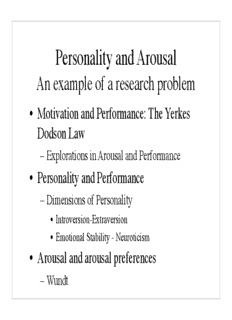
Arousal theory - The Personality Project PDF
Preview Arousal theory - The Personality Project
Personality and Arousal An example of a research problem • Motivation and Performance: The Yerkes Dodson Law – Explorations in Arousal and Performance • Personality and Performance – Dimensions of Personality • Introversion-Extraversion • Emotional Stability - Neuroticism • Arousal and arousal preferences – Wundt Behavioral Consequences of arousal differences • Differences in Arousal preference – Wundt’s curvilinear hypotheses • Moderate levels of arousal are more pleasing than extreme levels • (“the Goldilocks hypothesis”) – Berlyne • Changes in arousal are more pleasing than a steady state • Increases or decreases are pleasant Wundt’s hedonic curve (adapted from Berlyne) Pleasant > - e n o t c i n o d e H Boring Frightening Arousal potential -> Berlyne’s hedonic curve (adapted from Berlyne) Calming Exciting > - e n o t c i Adaptation to n o d Current State e H Frightening Boring Arousal potential -> Wundt’s hedonic curve + Individual Differences (adapted from Eysenck) Pleasant > Introverts Extraverts - e n o t c i n o d e Frightening H Boring Arousal potential of situation -> Yerkes Dodson “Law” • Electric shock as drive inducer – 4-5 levels of shock • Discrimination Learning – 3 levels of difficulty • Performance as interactive effect of difficulty and drive • Interpreted as inverted U relationship between arousal and performance Yerkes and Dodson, 1908 Discrimination learning Yerkes and Dodson Learning and shock level Yerkes and Dodson, 1908 Yerkes and Dodson curve in terms of arousal and task difficulty Easy Moderate e c n a m r o f r e P Hard Arousal - >
Description: